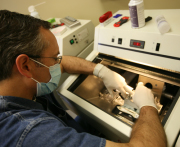Mohs Micrographic Surgery is a highly specialized procedure for the total removal of skin cancers under microscopic control. Because each layer is examined microscopically, dermatologists can be reasonably certain that all of the cancer has been eradicated while saving as much normal skin as possible, and resulting in the highest rate of cure.
Dr. Tanya Riddle is a member of the American Society of Mohs Surgery, and is a fellowship-trained, triple board certified dermatologist. She has three board certifications in dermatology, dermatopathology, and micrographic dermatologic surgery (Mohs surgery).
Last year Dr. Riddle performed over 400 cases of Mohs surgery at Billings Dermatology & Aesthetics. Our Mohs patients come to us from a wide geographical area, spanning Montana, Wyoming, North Dakota and South Dakota. We are committed to ensuring our local and regional patients are provided the highest quality of medical and surgical care, excellence in customer service, and warm hospitality during their procedure.

